University Quality Management Case Study Report: OPMG2258
VerifiedAdded on 2022/09/12
|12
|3011
|22
Report
AI Summary
This report provides a comprehensive analysis of a quality management case study, focusing on the challenges faced by an organization producing a degreasing solvent product (Greasex line). The report examines the issues related to high pressure injection during the packaging process, leading to product rejection, decreased production, and customer complaints. It explores the reasons behind the quality reduction, including lack of operator training, machine maintenance issues, and problems with the plastic nozzles. The report proposes solutions based on quality control theory, such as providing training, maintaining machines properly, and carefully selecting materials. The application of the fishbone diagram is discussed as a method to identify and solve the root causes of quality problems. The report emphasizes the importance of quality control in enhancing production and organizational growth.
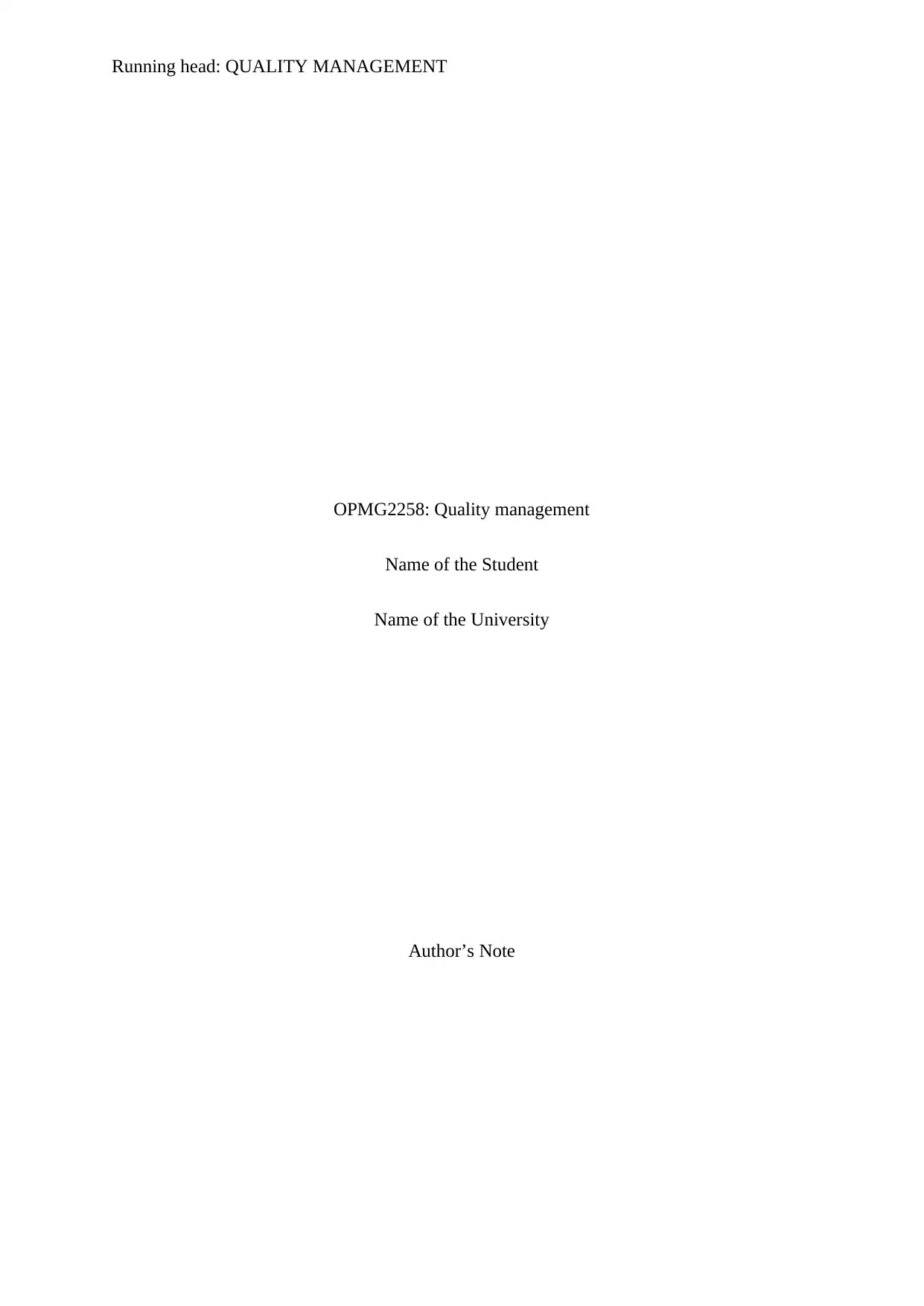
Running head: QUALITY MANAGEMENT
OPMG2258: Quality management
Name of the Student
Name of the University
Author’s Note
OPMG2258: Quality management
Name of the Student
Name of the University
Author’s Note
Paraphrase This Document
Need a fresh take? Get an instant paraphrase of this document with our AI Paraphraser
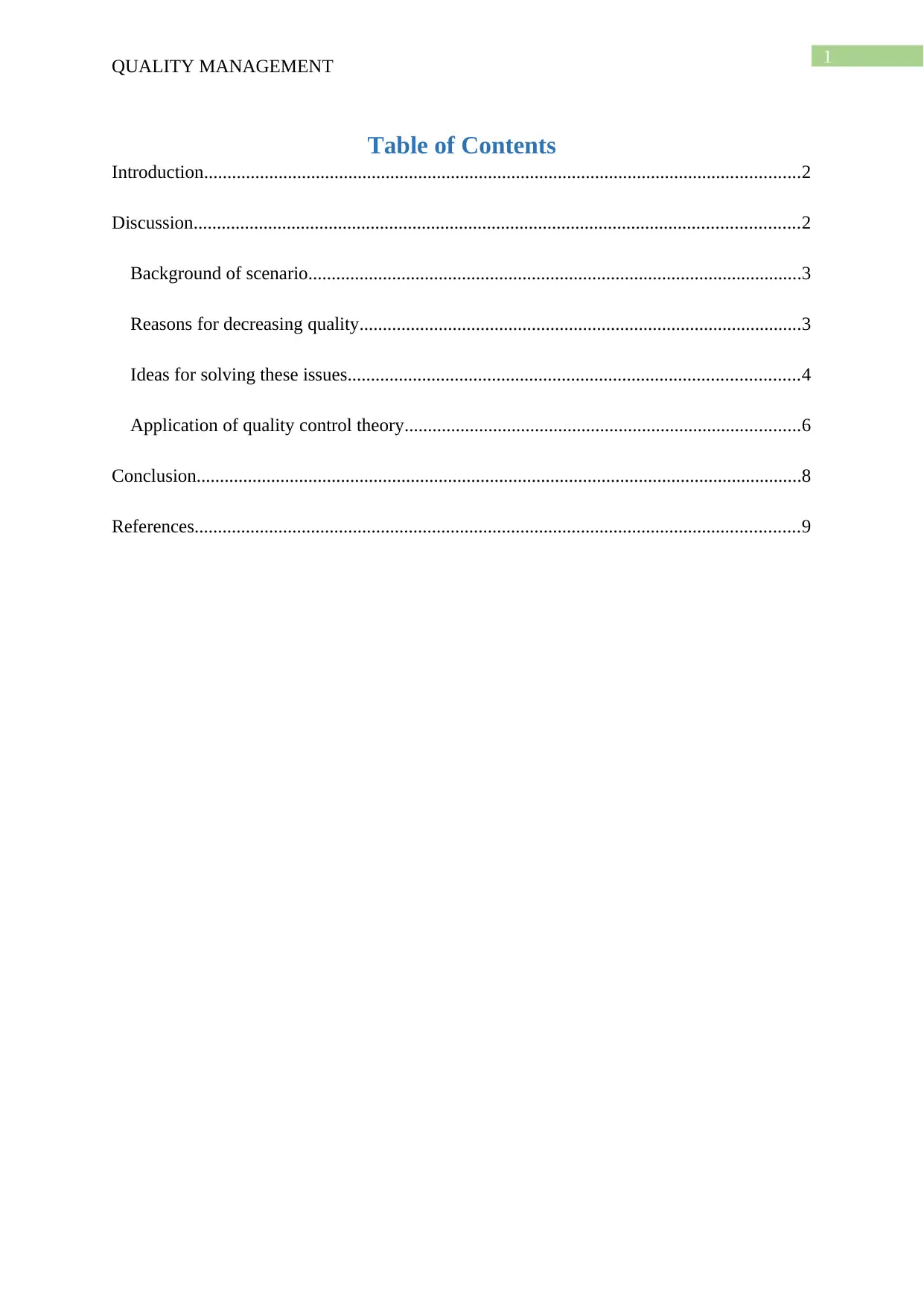
1
QUALITY MANAGEMENT
Table of Contents
Introduction................................................................................................................................2
Discussion..................................................................................................................................2
Background of scenario..........................................................................................................3
Reasons for decreasing quality...............................................................................................3
Ideas for solving these issues.................................................................................................4
Application of quality control theory.....................................................................................6
Conclusion..................................................................................................................................8
References..................................................................................................................................9
QUALITY MANAGEMENT
Table of Contents
Introduction................................................................................................................................2
Discussion..................................................................................................................................2
Background of scenario..........................................................................................................3
Reasons for decreasing quality...............................................................................................3
Ideas for solving these issues.................................................................................................4
Application of quality control theory.....................................................................................6
Conclusion..................................................................................................................................8
References..................................................................................................................................9

2
QUALITY MANAGEMENT
Introduction
The total quality management defines as a process by which the errors can be detected
or eliminated from the business operations. This management system helps to improve the
customer experience (Khudia et al., 2015). Moreover, for obtaining the perfect quality within
the operational process of organization, it needs to provide the exact training to the workers
and also hire the quality workers for smoothing the operational activities of the organization.
Around the competitive business market, it is challenged for all of the organizations to
deliver the best quality services to the customers so that they can help to growth the business
volume by purchasing or utilizing those services.
As mentioned in the case scenario, the organization has been faced lots of quality
related issues on their product manufacturing (Ingason, 2015). The case study shows that the
organization is producing the Greasex line considering as the degreasing solvent that is
packed in the spray can for high technology related sector. But now the organization has
faced the quality issues regarding the high pressure injected during the packaging time of can
compared to standard quantity (Goetsch & Davis, 2014). For that, some of the carton of cans
are considered as rejected instead of having delivery schedule and in this way, the
organization has faced the issues regarding low production, customer complaint etc. In this
report, it follows how the quality control theory aids to mitigate the issues.
Discussion
As stated by (Kaziliūnas, 2014), the total quality management mentions as a continual
process by which the errors of the operational activities are detected and also eliminated. By
defining the total quality management, it has to say that this system helps to detect the errors
and whether if the errors are justified, it requires to rectify otherwise it go to the elimination
section. Moreover, it also helps to streamline the supply chain management for improving the
QUALITY MANAGEMENT
Introduction
The total quality management defines as a process by which the errors can be detected
or eliminated from the business operations. This management system helps to improve the
customer experience (Khudia et al., 2015). Moreover, for obtaining the perfect quality within
the operational process of organization, it needs to provide the exact training to the workers
and also hire the quality workers for smoothing the operational activities of the organization.
Around the competitive business market, it is challenged for all of the organizations to
deliver the best quality services to the customers so that they can help to growth the business
volume by purchasing or utilizing those services.
As mentioned in the case scenario, the organization has been faced lots of quality
related issues on their product manufacturing (Ingason, 2015). The case study shows that the
organization is producing the Greasex line considering as the degreasing solvent that is
packed in the spray can for high technology related sector. But now the organization has
faced the quality issues regarding the high pressure injected during the packaging time of can
compared to standard quantity (Goetsch & Davis, 2014). For that, some of the carton of cans
are considered as rejected instead of having delivery schedule and in this way, the
organization has faced the issues regarding low production, customer complaint etc. In this
report, it follows how the quality control theory aids to mitigate the issues.
Discussion
As stated by (Kaziliūnas, 2014), the total quality management mentions as a continual
process by which the errors of the operational activities are detected and also eliminated. By
defining the total quality management, it has to say that this system helps to detect the errors
and whether if the errors are justified, it requires to rectify otherwise it go to the elimination
section. Moreover, it also helps to streamline the supply chain management for improving the
⊘ This is a preview!⊘
Do you want full access?
Subscribe today to unlock all pages.

Trusted by 1+ million students worldwide
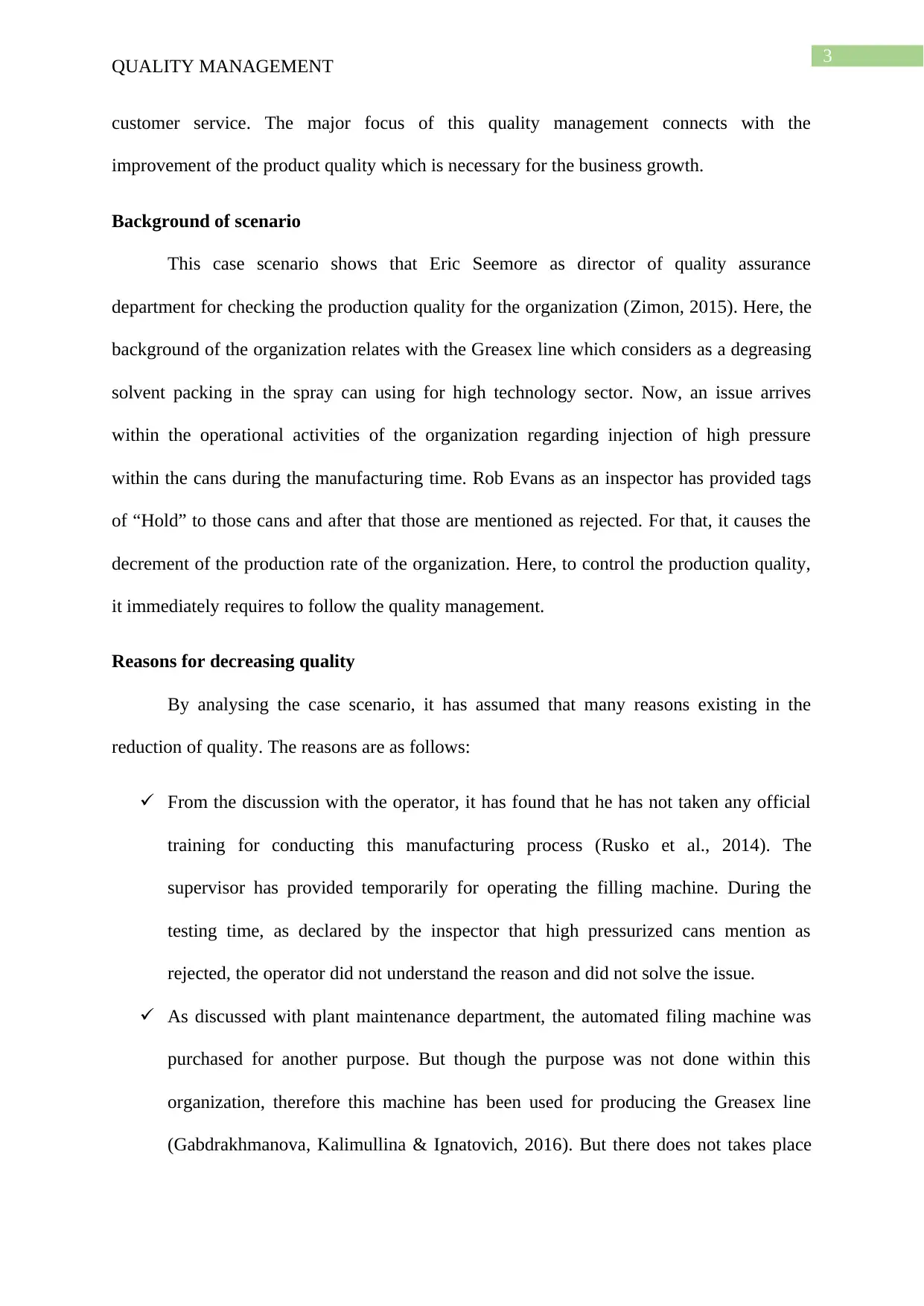
3
QUALITY MANAGEMENT
customer service. The major focus of this quality management connects with the
improvement of the product quality which is necessary for the business growth.
Background of scenario
This case scenario shows that Eric Seemore as director of quality assurance
department for checking the production quality for the organization (Zimon, 2015). Here, the
background of the organization relates with the Greasex line which considers as a degreasing
solvent packing in the spray can using for high technology sector. Now, an issue arrives
within the operational activities of the organization regarding injection of high pressure
within the cans during the manufacturing time. Rob Evans as an inspector has provided tags
of “Hold” to those cans and after that those are mentioned as rejected. For that, it causes the
decrement of the production rate of the organization. Here, to control the production quality,
it immediately requires to follow the quality management.
Reasons for decreasing quality
By analysing the case scenario, it has assumed that many reasons existing in the
reduction of quality. The reasons are as follows:
From the discussion with the operator, it has found that he has not taken any official
training for conducting this manufacturing process (Rusko et al., 2014). The
supervisor has provided temporarily for operating the filling machine. During the
testing time, as declared by the inspector that high pressurized cans mention as
rejected, the operator did not understand the reason and did not solve the issue.
As discussed with plant maintenance department, the automated filing machine was
purchased for another purpose. But though the purpose was not done within this
organization, therefore this machine has been used for producing the Greasex line
(Gabdrakhmanova, Kalimullina & Ignatovich, 2016). But there does not takes place
QUALITY MANAGEMENT
customer service. The major focus of this quality management connects with the
improvement of the product quality which is necessary for the business growth.
Background of scenario
This case scenario shows that Eric Seemore as director of quality assurance
department for checking the production quality for the organization (Zimon, 2015). Here, the
background of the organization relates with the Greasex line which considers as a degreasing
solvent packing in the spray can using for high technology sector. Now, an issue arrives
within the operational activities of the organization regarding injection of high pressure
within the cans during the manufacturing time. Rob Evans as an inspector has provided tags
of “Hold” to those cans and after that those are mentioned as rejected. For that, it causes the
decrement of the production rate of the organization. Here, to control the production quality,
it immediately requires to follow the quality management.
Reasons for decreasing quality
By analysing the case scenario, it has assumed that many reasons existing in the
reduction of quality. The reasons are as follows:
From the discussion with the operator, it has found that he has not taken any official
training for conducting this manufacturing process (Rusko et al., 2014). The
supervisor has provided temporarily for operating the filling machine. During the
testing time, as declared by the inspector that high pressurized cans mention as
rejected, the operator did not understand the reason and did not solve the issue.
As discussed with plant maintenance department, the automated filing machine was
purchased for another purpose. But though the purpose was not done within this
organization, therefore this machine has been used for producing the Greasex line
(Gabdrakhmanova, Kalimullina & Ignatovich, 2016). But there does not takes place
Paraphrase This Document
Need a fresh take? Get an instant paraphrase of this document with our AI Paraphraser
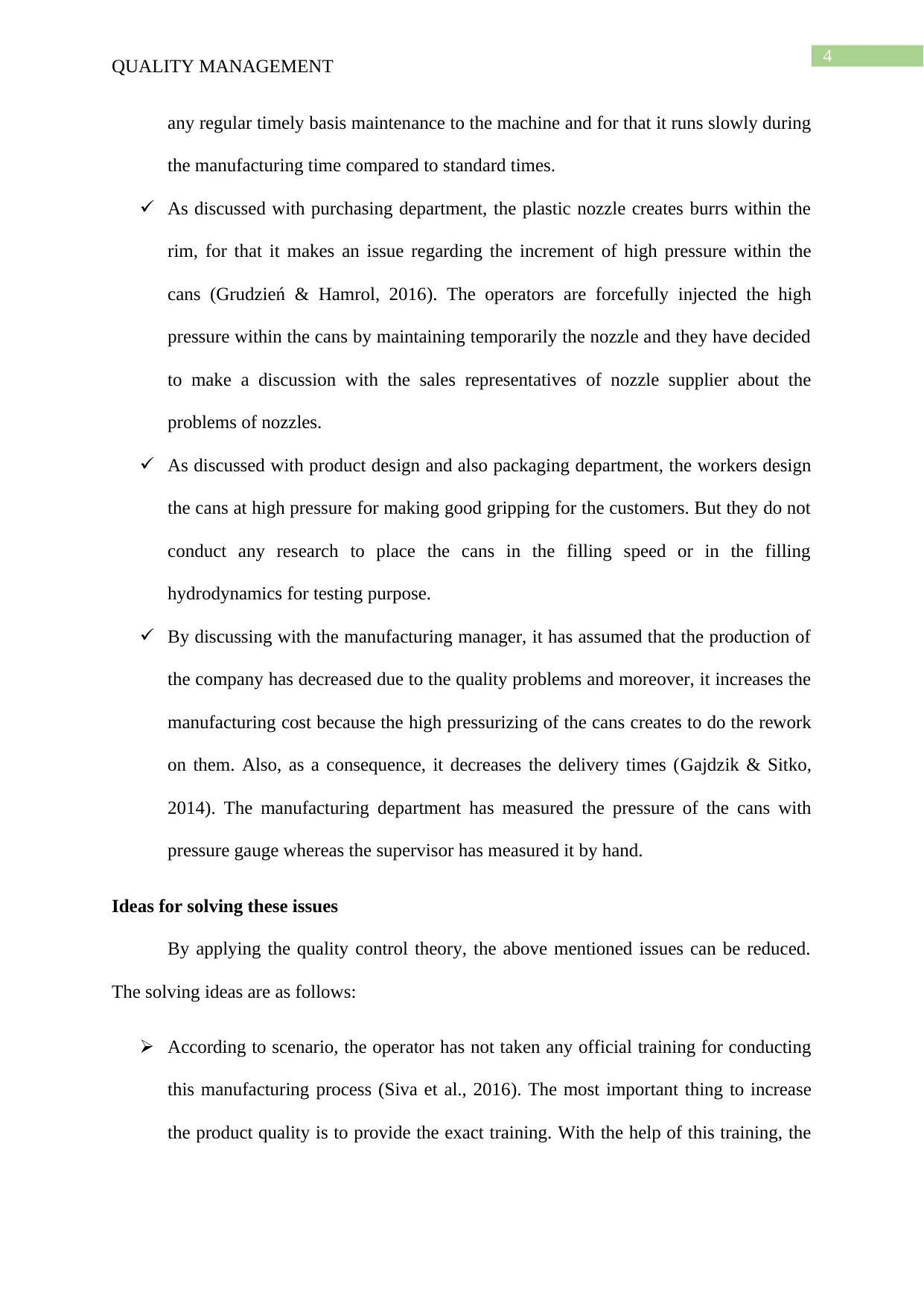
4
QUALITY MANAGEMENT
any regular timely basis maintenance to the machine and for that it runs slowly during
the manufacturing time compared to standard times.
As discussed with purchasing department, the plastic nozzle creates burrs within the
rim, for that it makes an issue regarding the increment of high pressure within the
cans (Grudzień & Hamrol, 2016). The operators are forcefully injected the high
pressure within the cans by maintaining temporarily the nozzle and they have decided
to make a discussion with the sales representatives of nozzle supplier about the
problems of nozzles.
As discussed with product design and also packaging department, the workers design
the cans at high pressure for making good gripping for the customers. But they do not
conduct any research to place the cans in the filling speed or in the filling
hydrodynamics for testing purpose.
By discussing with the manufacturing manager, it has assumed that the production of
the company has decreased due to the quality problems and moreover, it increases the
manufacturing cost because the high pressurizing of the cans creates to do the rework
on them. Also, as a consequence, it decreases the delivery times (Gajdzik & Sitko,
2014). The manufacturing department has measured the pressure of the cans with
pressure gauge whereas the supervisor has measured it by hand.
Ideas for solving these issues
By applying the quality control theory, the above mentioned issues can be reduced.
The solving ideas are as follows:
According to scenario, the operator has not taken any official training for conducting
this manufacturing process (Siva et al., 2016). The most important thing to increase
the product quality is to provide the exact training. With the help of this training, the
QUALITY MANAGEMENT
any regular timely basis maintenance to the machine and for that it runs slowly during
the manufacturing time compared to standard times.
As discussed with purchasing department, the plastic nozzle creates burrs within the
rim, for that it makes an issue regarding the increment of high pressure within the
cans (Grudzień & Hamrol, 2016). The operators are forcefully injected the high
pressure within the cans by maintaining temporarily the nozzle and they have decided
to make a discussion with the sales representatives of nozzle supplier about the
problems of nozzles.
As discussed with product design and also packaging department, the workers design
the cans at high pressure for making good gripping for the customers. But they do not
conduct any research to place the cans in the filling speed or in the filling
hydrodynamics for testing purpose.
By discussing with the manufacturing manager, it has assumed that the production of
the company has decreased due to the quality problems and moreover, it increases the
manufacturing cost because the high pressurizing of the cans creates to do the rework
on them. Also, as a consequence, it decreases the delivery times (Gajdzik & Sitko,
2014). The manufacturing department has measured the pressure of the cans with
pressure gauge whereas the supervisor has measured it by hand.
Ideas for solving these issues
By applying the quality control theory, the above mentioned issues can be reduced.
The solving ideas are as follows:
According to scenario, the operator has not taken any official training for conducting
this manufacturing process (Siva et al., 2016). The most important thing to increase
the product quality is to provide the exact training. With the help of this training, the
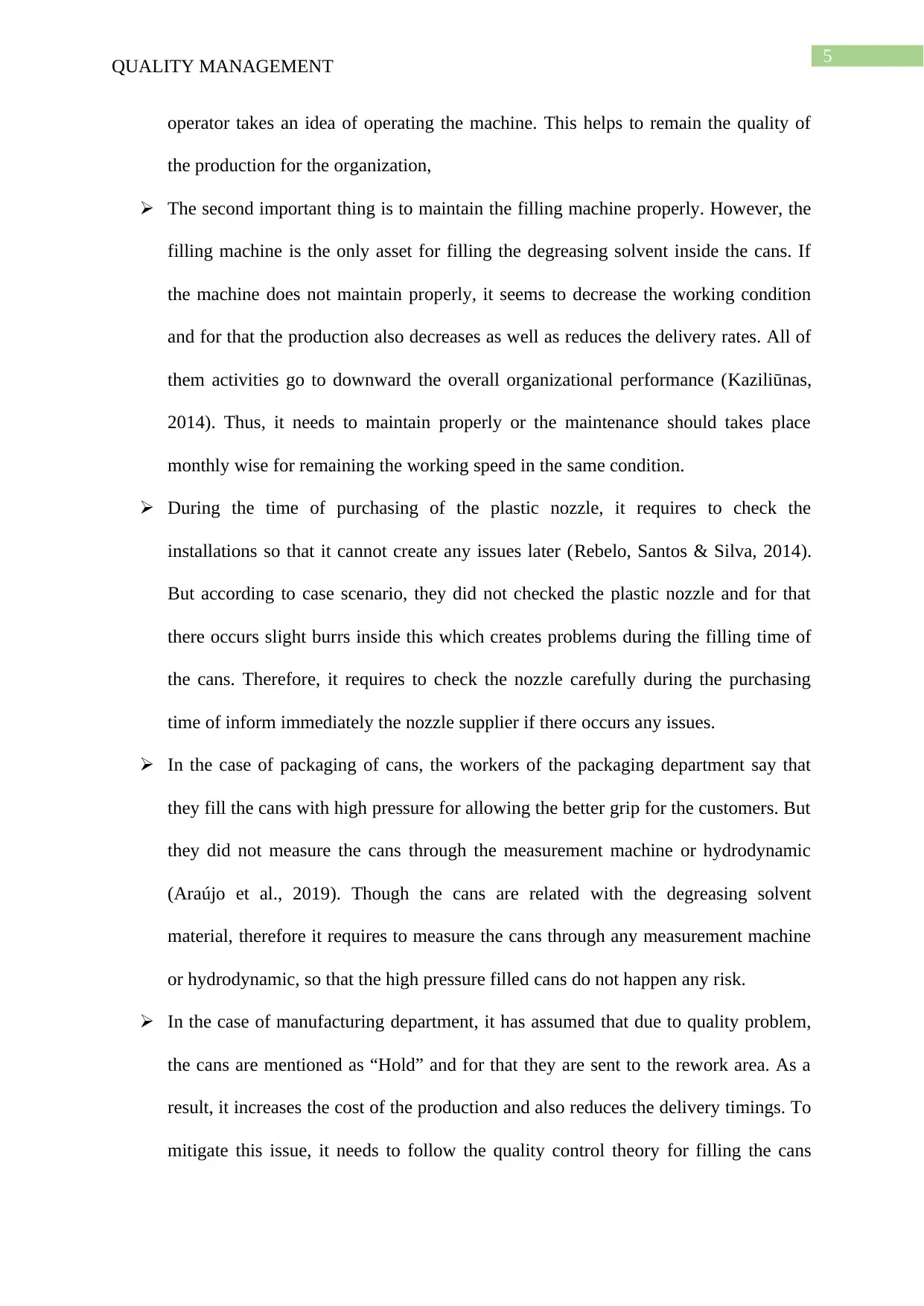
5
QUALITY MANAGEMENT
operator takes an idea of operating the machine. This helps to remain the quality of
the production for the organization,
The second important thing is to maintain the filling machine properly. However, the
filling machine is the only asset for filling the degreasing solvent inside the cans. If
the machine does not maintain properly, it seems to decrease the working condition
and for that the production also decreases as well as reduces the delivery rates. All of
them activities go to downward the overall organizational performance (Kaziliūnas,
2014). Thus, it needs to maintain properly or the maintenance should takes place
monthly wise for remaining the working speed in the same condition.
During the time of purchasing of the plastic nozzle, it requires to check the
installations so that it cannot create any issues later (Rebelo, Santos & Silva, 2014).
But according to case scenario, they did not checked the plastic nozzle and for that
there occurs slight burrs inside this which creates problems during the filling time of
the cans. Therefore, it requires to check the nozzle carefully during the purchasing
time of inform immediately the nozzle supplier if there occurs any issues.
In the case of packaging of cans, the workers of the packaging department say that
they fill the cans with high pressure for allowing the better grip for the customers. But
they did not measure the cans through the measurement machine or hydrodynamic
(Araújo et al., 2019). Though the cans are related with the degreasing solvent
material, therefore it requires to measure the cans through any measurement machine
or hydrodynamic, so that the high pressure filled cans do not happen any risk.
In the case of manufacturing department, it has assumed that due to quality problem,
the cans are mentioned as “Hold” and for that they are sent to the rework area. As a
result, it increases the cost of the production and also reduces the delivery timings. To
mitigate this issue, it needs to follow the quality control theory for filling the cans
QUALITY MANAGEMENT
operator takes an idea of operating the machine. This helps to remain the quality of
the production for the organization,
The second important thing is to maintain the filling machine properly. However, the
filling machine is the only asset for filling the degreasing solvent inside the cans. If
the machine does not maintain properly, it seems to decrease the working condition
and for that the production also decreases as well as reduces the delivery rates. All of
them activities go to downward the overall organizational performance (Kaziliūnas,
2014). Thus, it needs to maintain properly or the maintenance should takes place
monthly wise for remaining the working speed in the same condition.
During the time of purchasing of the plastic nozzle, it requires to check the
installations so that it cannot create any issues later (Rebelo, Santos & Silva, 2014).
But according to case scenario, they did not checked the plastic nozzle and for that
there occurs slight burrs inside this which creates problems during the filling time of
the cans. Therefore, it requires to check the nozzle carefully during the purchasing
time of inform immediately the nozzle supplier if there occurs any issues.
In the case of packaging of cans, the workers of the packaging department say that
they fill the cans with high pressure for allowing the better grip for the customers. But
they did not measure the cans through the measurement machine or hydrodynamic
(Araújo et al., 2019). Though the cans are related with the degreasing solvent
material, therefore it requires to measure the cans through any measurement machine
or hydrodynamic, so that the high pressure filled cans do not happen any risk.
In the case of manufacturing department, it has assumed that due to quality problem,
the cans are mentioned as “Hold” and for that they are sent to the rework area. As a
result, it increases the cost of the production and also reduces the delivery timings. To
mitigate this issue, it needs to follow the quality control theory for filling the cans
⊘ This is a preview!⊘
Do you want full access?
Subscribe today to unlock all pages.

Trusted by 1+ million students worldwide

6
QUALITY MANAGEMENT
with pressure during the manufacturing time (Oakland, 2014). Therefore, it enhances
the quality as well as quantity of production and achieves a huge range of customers.
Application of quality control theory
The quality control theory is a specific kind of theory by which the quality of the
production can be measured of any organization (Sviridova, 2015). Within the organizations,
there exists a quality inspector who checks the quality of the production. The organizational
growth along with the increment of the attractions of the customers depends on the quality
production.
Here, based on the case scenario, the organization have faced the quality issues
regarding the filling of the high pressure inside the cans of degreasing solvent which is used
for high technology sector (Patel, 2016). Since, the cans are filled with high pressure,
therefore it creates several risks as well as quality issues. However, happening of this
scenario, the inspector has provided the tags of “Hold” to the cans and has sent them to the
rework area (Kafetzopoulos & Gotzamani, 2014). For sending the cans to rework, it increases
the cost of the production and moreover it reduces the delivery as well as production. For
that, it happens to degrade the business growth. In this case, the quality assurance director has
the responsibility to check the quality of the production for enhancing the organizational
growth.
He needs to follow the quality control theory by which he can able to control the
quality issues and helps to enhance the organizational production. To control the quality, he
should follow the fishbone diagram. However, this fishbone diagram aids to determine the
causes as well as effects of the organization (Pronovost & Marsteller, 2014). It consists of
some major branches along with minor branches. The major branches helps to determine
major influences which leads to solve out the issues. The branches are given in below:
QUALITY MANAGEMENT
with pressure during the manufacturing time (Oakland, 2014). Therefore, it enhances
the quality as well as quantity of production and achieves a huge range of customers.
Application of quality control theory
The quality control theory is a specific kind of theory by which the quality of the
production can be measured of any organization (Sviridova, 2015). Within the organizations,
there exists a quality inspector who checks the quality of the production. The organizational
growth along with the increment of the attractions of the customers depends on the quality
production.
Here, based on the case scenario, the organization have faced the quality issues
regarding the filling of the high pressure inside the cans of degreasing solvent which is used
for high technology sector (Patel, 2016). Since, the cans are filled with high pressure,
therefore it creates several risks as well as quality issues. However, happening of this
scenario, the inspector has provided the tags of “Hold” to the cans and has sent them to the
rework area (Kafetzopoulos & Gotzamani, 2014). For sending the cans to rework, it increases
the cost of the production and moreover it reduces the delivery as well as production. For
that, it happens to degrade the business growth. In this case, the quality assurance director has
the responsibility to check the quality of the production for enhancing the organizational
growth.
He needs to follow the quality control theory by which he can able to control the
quality issues and helps to enhance the organizational production. To control the quality, he
should follow the fishbone diagram. However, this fishbone diagram aids to determine the
causes as well as effects of the organization (Pronovost & Marsteller, 2014). It consists of
some major branches along with minor branches. The major branches helps to determine
major influences which leads to solve out the issues. The branches are given in below:
Paraphrase This Document
Need a fresh take? Get an instant paraphrase of this document with our AI Paraphraser
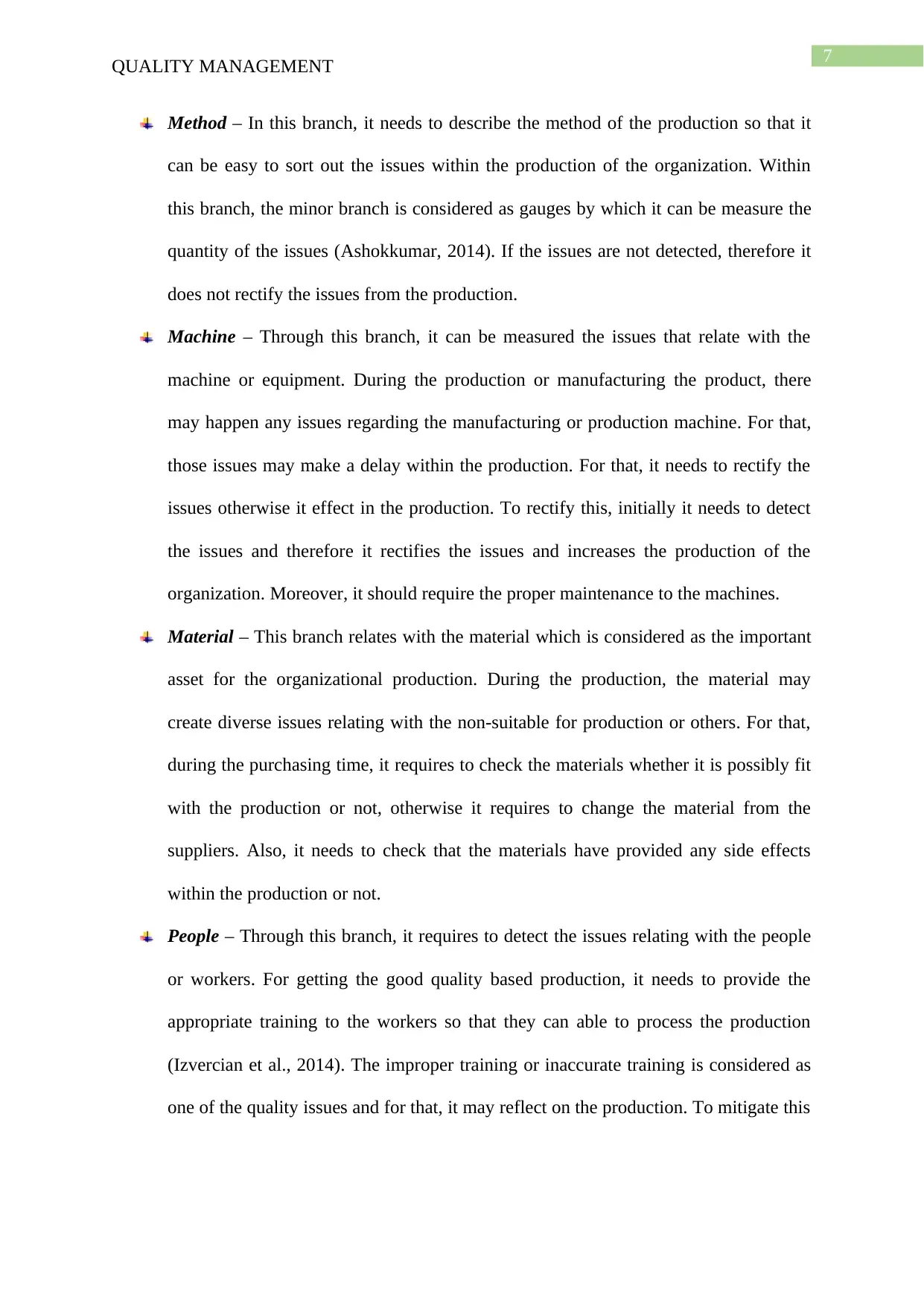
7
QUALITY MANAGEMENT
Method – In this branch, it needs to describe the method of the production so that it
can be easy to sort out the issues within the production of the organization. Within
this branch, the minor branch is considered as gauges by which it can be measure the
quantity of the issues (Ashokkumar, 2014). If the issues are not detected, therefore it
does not rectify the issues from the production.
Machine – Through this branch, it can be measured the issues that relate with the
machine or equipment. During the production or manufacturing the product, there
may happen any issues regarding the manufacturing or production machine. For that,
those issues may make a delay within the production. For that, it needs to rectify the
issues otherwise it effect in the production. To rectify this, initially it needs to detect
the issues and therefore it rectifies the issues and increases the production of the
organization. Moreover, it should require the proper maintenance to the machines.
Material – This branch relates with the material which is considered as the important
asset for the organizational production. During the production, the material may
create diverse issues relating with the non-suitable for production or others. For that,
during the purchasing time, it requires to check the materials whether it is possibly fit
with the production or not, otherwise it requires to change the material from the
suppliers. Also, it needs to check that the materials have provided any side effects
within the production or not.
People – Through this branch, it requires to detect the issues relating with the people
or workers. For getting the good quality based production, it needs to provide the
appropriate training to the workers so that they can able to process the production
(Izvercian et al., 2014). The improper training or inaccurate training is considered as
one of the quality issues and for that, it may reflect on the production. To mitigate this
QUALITY MANAGEMENT
Method – In this branch, it needs to describe the method of the production so that it
can be easy to sort out the issues within the production of the organization. Within
this branch, the minor branch is considered as gauges by which it can be measure the
quantity of the issues (Ashokkumar, 2014). If the issues are not detected, therefore it
does not rectify the issues from the production.
Machine – Through this branch, it can be measured the issues that relate with the
machine or equipment. During the production or manufacturing the product, there
may happen any issues regarding the manufacturing or production machine. For that,
those issues may make a delay within the production. For that, it needs to rectify the
issues otherwise it effect in the production. To rectify this, initially it needs to detect
the issues and therefore it rectifies the issues and increases the production of the
organization. Moreover, it should require the proper maintenance to the machines.
Material – This branch relates with the material which is considered as the important
asset for the organizational production. During the production, the material may
create diverse issues relating with the non-suitable for production or others. For that,
during the purchasing time, it requires to check the materials whether it is possibly fit
with the production or not, otherwise it requires to change the material from the
suppliers. Also, it needs to check that the materials have provided any side effects
within the production or not.
People – Through this branch, it requires to detect the issues relating with the people
or workers. For getting the good quality based production, it needs to provide the
appropriate training to the workers so that they can able to process the production
(Izvercian et al., 2014). The improper training or inaccurate training is considered as
one of the quality issues and for that, it may reflect on the production. To mitigate this
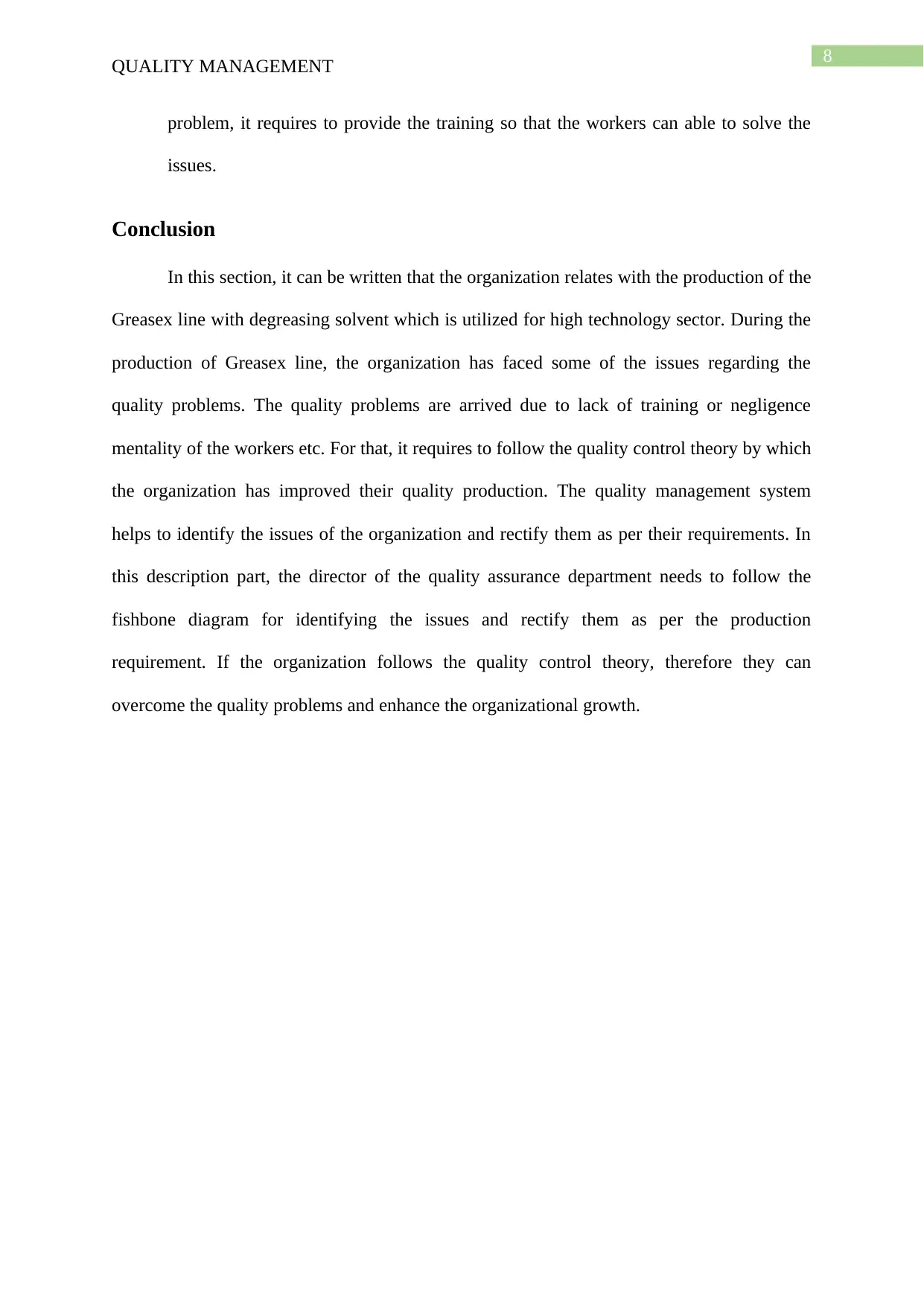
8
QUALITY MANAGEMENT
problem, it requires to provide the training so that the workers can able to solve the
issues.
Conclusion
In this section, it can be written that the organization relates with the production of the
Greasex line with degreasing solvent which is utilized for high technology sector. During the
production of Greasex line, the organization has faced some of the issues regarding the
quality problems. The quality problems are arrived due to lack of training or negligence
mentality of the workers etc. For that, it requires to follow the quality control theory by which
the organization has improved their quality production. The quality management system
helps to identify the issues of the organization and rectify them as per their requirements. In
this description part, the director of the quality assurance department needs to follow the
fishbone diagram for identifying the issues and rectify them as per the production
requirement. If the organization follows the quality control theory, therefore they can
overcome the quality problems and enhance the organizational growth.
QUALITY MANAGEMENT
problem, it requires to provide the training so that the workers can able to solve the
issues.
Conclusion
In this section, it can be written that the organization relates with the production of the
Greasex line with degreasing solvent which is utilized for high technology sector. During the
production of Greasex line, the organization has faced some of the issues regarding the
quality problems. The quality problems are arrived due to lack of training or negligence
mentality of the workers etc. For that, it requires to follow the quality control theory by which
the organization has improved their quality production. The quality management system
helps to identify the issues of the organization and rectify them as per their requirements. In
this description part, the director of the quality assurance department needs to follow the
fishbone diagram for identifying the issues and rectify them as per the production
requirement. If the organization follows the quality control theory, therefore they can
overcome the quality problems and enhance the organizational growth.
⊘ This is a preview!⊘
Do you want full access?
Subscribe today to unlock all pages.

Trusted by 1+ million students worldwide
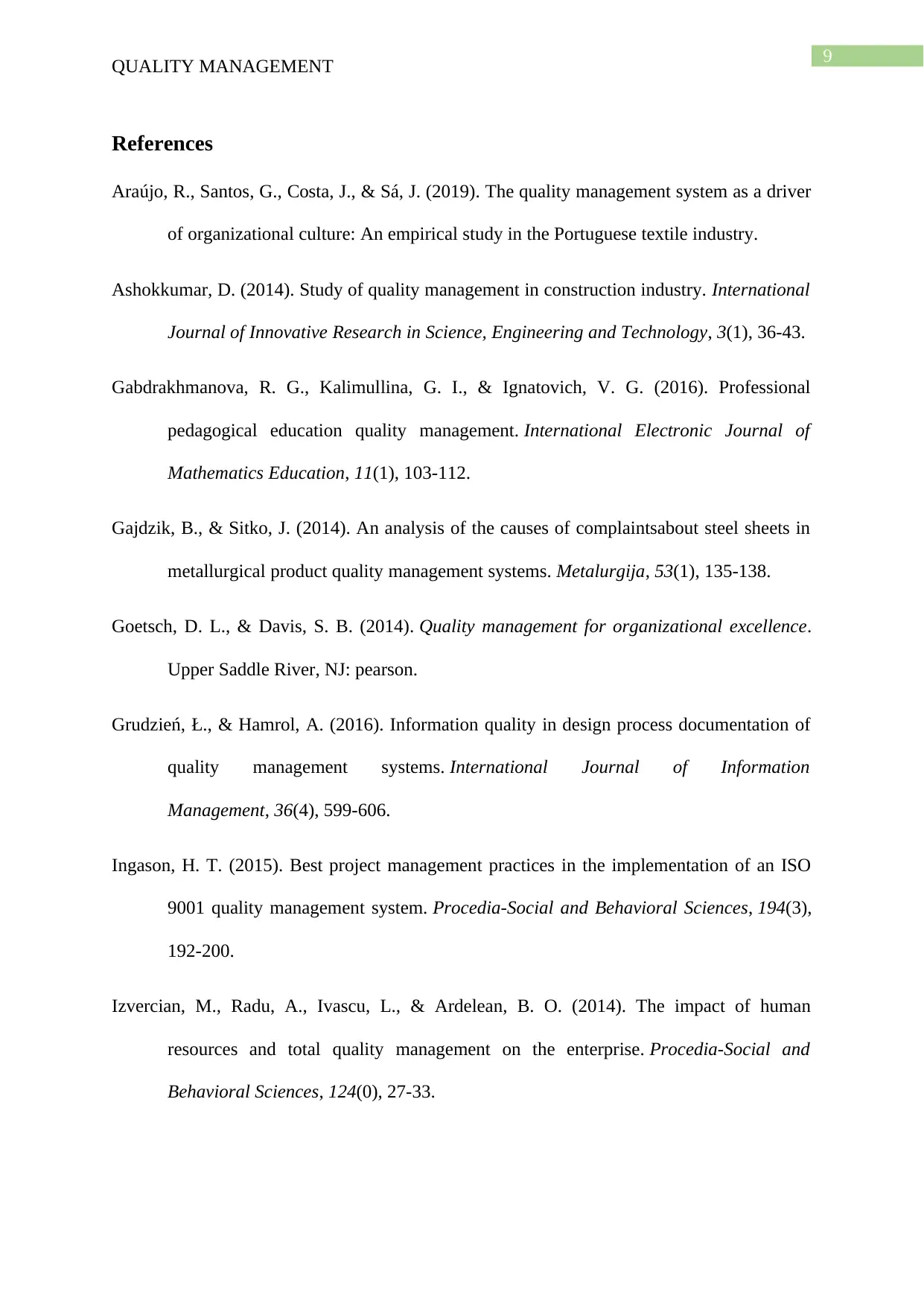
9
QUALITY MANAGEMENT
References
Araújo, R., Santos, G., Costa, J., & Sá, J. (2019). The quality management system as a driver
of organizational culture: An empirical study in the Portuguese textile industry.
Ashokkumar, D. (2014). Study of quality management in construction industry. International
Journal of Innovative Research in Science, Engineering and Technology, 3(1), 36-43.
Gabdrakhmanova, R. G., Kalimullina, G. I., & Ignatovich, V. G. (2016). Professional
pedagogical education quality management. International Electronic Journal of
Mathematics Education, 11(1), 103-112.
Gajdzik, B., & Sitko, J. (2014). An analysis of the causes of complaintsabout steel sheets in
metallurgical product quality management systems. Metalurgija, 53(1), 135-138.
Goetsch, D. L., & Davis, S. B. (2014). Quality management for organizational excellence.
Upper Saddle River, NJ: pearson.
Grudzień, Ł., & Hamrol, A. (2016). Information quality in design process documentation of
quality management systems. International Journal of Information
Management, 36(4), 599-606.
Ingason, H. T. (2015). Best project management practices in the implementation of an ISO
9001 quality management system. Procedia-Social and Behavioral Sciences, 194(3),
192-200.
Izvercian, M., Radu, A., Ivascu, L., & Ardelean, B. O. (2014). The impact of human
resources and total quality management on the enterprise. Procedia-Social and
Behavioral Sciences, 124(0), 27-33.
QUALITY MANAGEMENT
References
Araújo, R., Santos, G., Costa, J., & Sá, J. (2019). The quality management system as a driver
of organizational culture: An empirical study in the Portuguese textile industry.
Ashokkumar, D. (2014). Study of quality management in construction industry. International
Journal of Innovative Research in Science, Engineering and Technology, 3(1), 36-43.
Gabdrakhmanova, R. G., Kalimullina, G. I., & Ignatovich, V. G. (2016). Professional
pedagogical education quality management. International Electronic Journal of
Mathematics Education, 11(1), 103-112.
Gajdzik, B., & Sitko, J. (2014). An analysis of the causes of complaintsabout steel sheets in
metallurgical product quality management systems. Metalurgija, 53(1), 135-138.
Goetsch, D. L., & Davis, S. B. (2014). Quality management for organizational excellence.
Upper Saddle River, NJ: pearson.
Grudzień, Ł., & Hamrol, A. (2016). Information quality in design process documentation of
quality management systems. International Journal of Information
Management, 36(4), 599-606.
Ingason, H. T. (2015). Best project management practices in the implementation of an ISO
9001 quality management system. Procedia-Social and Behavioral Sciences, 194(3),
192-200.
Izvercian, M., Radu, A., Ivascu, L., & Ardelean, B. O. (2014). The impact of human
resources and total quality management on the enterprise. Procedia-Social and
Behavioral Sciences, 124(0), 27-33.
Paraphrase This Document
Need a fresh take? Get an instant paraphrase of this document with our AI Paraphraser
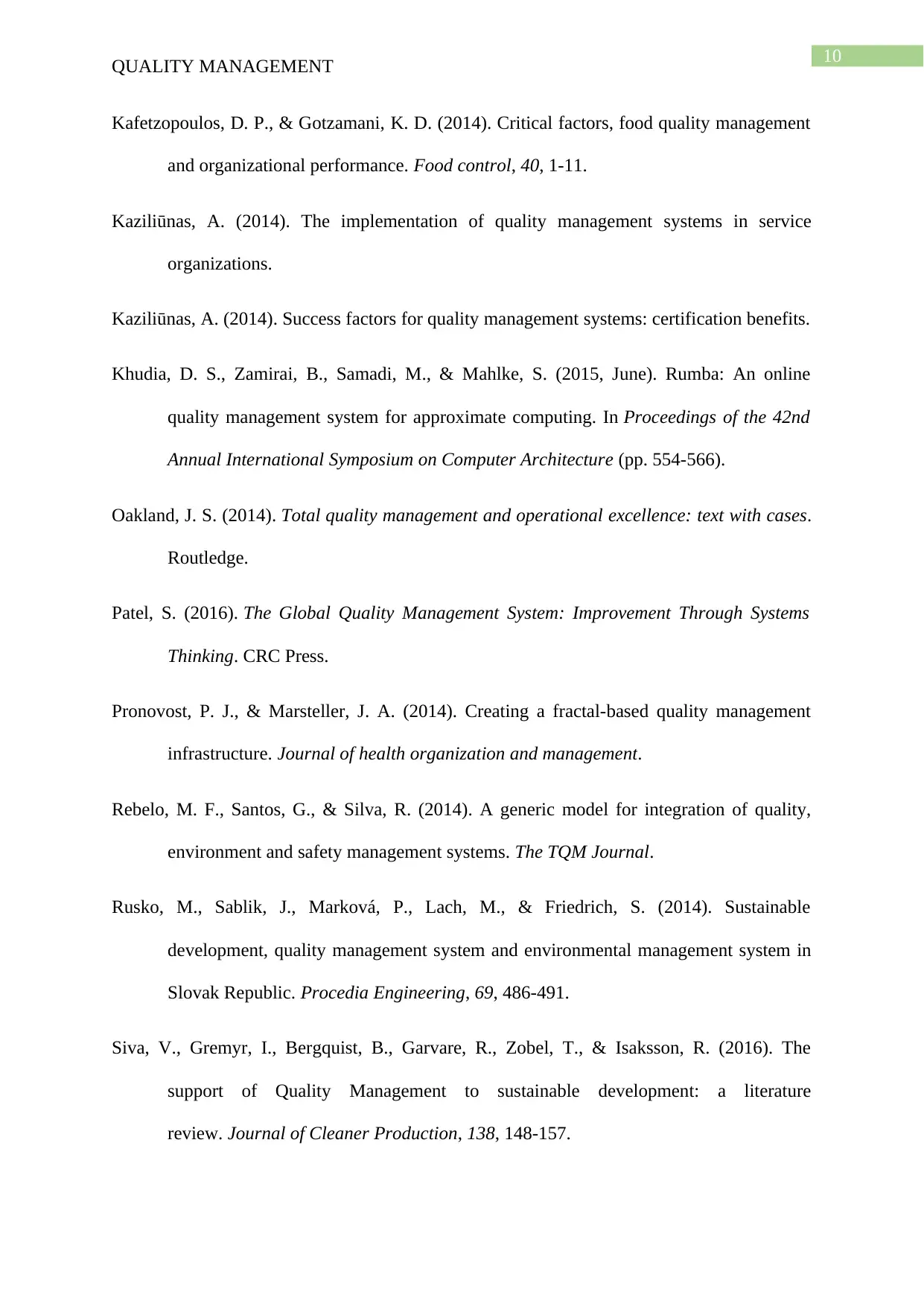
10
QUALITY MANAGEMENT
Kafetzopoulos, D. P., & Gotzamani, K. D. (2014). Critical factors, food quality management
and organizational performance. Food control, 40, 1-11.
Kaziliūnas, A. (2014). The implementation of quality management systems in service
organizations.
Kaziliūnas, A. (2014). Success factors for quality management systems: certification benefits.
Khudia, D. S., Zamirai, B., Samadi, M., & Mahlke, S. (2015, June). Rumba: An online
quality management system for approximate computing. In Proceedings of the 42nd
Annual International Symposium on Computer Architecture (pp. 554-566).
Oakland, J. S. (2014). Total quality management and operational excellence: text with cases.
Routledge.
Patel, S. (2016). The Global Quality Management System: Improvement Through Systems
Thinking. CRC Press.
Pronovost, P. J., & Marsteller, J. A. (2014). Creating a fractal-based quality management
infrastructure. Journal of health organization and management.
Rebelo, M. F., Santos, G., & Silva, R. (2014). A generic model for integration of quality,
environment and safety management systems. The TQM Journal.
Rusko, M., Sablik, J., Marková, P., Lach, M., & Friedrich, S. (2014). Sustainable
development, quality management system and environmental management system in
Slovak Republic. Procedia Engineering, 69, 486-491.
Siva, V., Gremyr, I., Bergquist, B., Garvare, R., Zobel, T., & Isaksson, R. (2016). The
support of Quality Management to sustainable development: a literature
review. Journal of Cleaner Production, 138, 148-157.
QUALITY MANAGEMENT
Kafetzopoulos, D. P., & Gotzamani, K. D. (2014). Critical factors, food quality management
and organizational performance. Food control, 40, 1-11.
Kaziliūnas, A. (2014). The implementation of quality management systems in service
organizations.
Kaziliūnas, A. (2014). Success factors for quality management systems: certification benefits.
Khudia, D. S., Zamirai, B., Samadi, M., & Mahlke, S. (2015, June). Rumba: An online
quality management system for approximate computing. In Proceedings of the 42nd
Annual International Symposium on Computer Architecture (pp. 554-566).
Oakland, J. S. (2014). Total quality management and operational excellence: text with cases.
Routledge.
Patel, S. (2016). The Global Quality Management System: Improvement Through Systems
Thinking. CRC Press.
Pronovost, P. J., & Marsteller, J. A. (2014). Creating a fractal-based quality management
infrastructure. Journal of health organization and management.
Rebelo, M. F., Santos, G., & Silva, R. (2014). A generic model for integration of quality,
environment and safety management systems. The TQM Journal.
Rusko, M., Sablik, J., Marková, P., Lach, M., & Friedrich, S. (2014). Sustainable
development, quality management system and environmental management system in
Slovak Republic. Procedia Engineering, 69, 486-491.
Siva, V., Gremyr, I., Bergquist, B., Garvare, R., Zobel, T., & Isaksson, R. (2016). The
support of Quality Management to sustainable development: a literature
review. Journal of Cleaner Production, 138, 148-157.

11
QUALITY MANAGEMENT
Sviridova, O. I. (2015). Bases of formation of quality management system in agricultural
enterprises. Вестник аграрной науки, 53(2).’
Zimon, D. (2015). IMPACT OF THE IMPLEMENTATION OF QUALITY
MANAGEMENT SYSTEM ON OPERATING COST FOR SMALL AND
MEDIUM-SIZED BUSINESS ORGANIZATIONS AFFILIATED TO A
PURCHASING GROUP. International Journal for Quality Research, 9(4).
QUALITY MANAGEMENT
Sviridova, O. I. (2015). Bases of formation of quality management system in agricultural
enterprises. Вестник аграрной науки, 53(2).’
Zimon, D. (2015). IMPACT OF THE IMPLEMENTATION OF QUALITY
MANAGEMENT SYSTEM ON OPERATING COST FOR SMALL AND
MEDIUM-SIZED BUSINESS ORGANIZATIONS AFFILIATED TO A
PURCHASING GROUP. International Journal for Quality Research, 9(4).
⊘ This is a preview!⊘
Do you want full access?
Subscribe today to unlock all pages.

Trusted by 1+ million students worldwide
1 out of 12
Related Documents
Your All-in-One AI-Powered Toolkit for Academic Success.
+13062052269
info@desklib.com
Available 24*7 on WhatsApp / Email
![[object Object]](/_next/static/media/star-bottom.7253800d.svg)
Unlock your academic potential
Copyright © 2020–2025 A2Z Services. All Rights Reserved. Developed and managed by ZUCOL.




